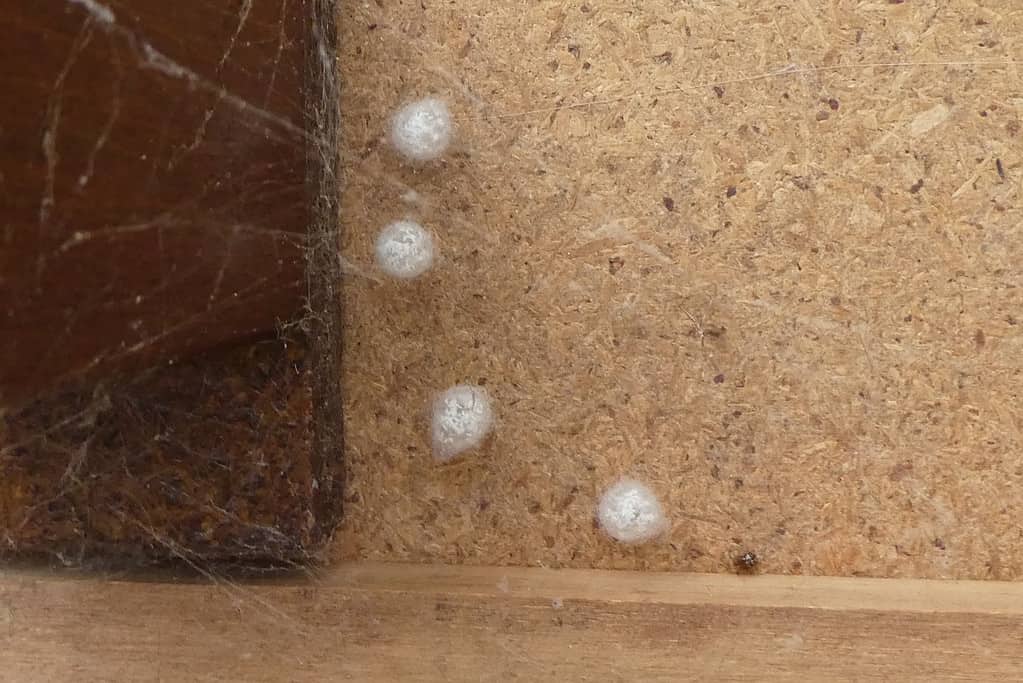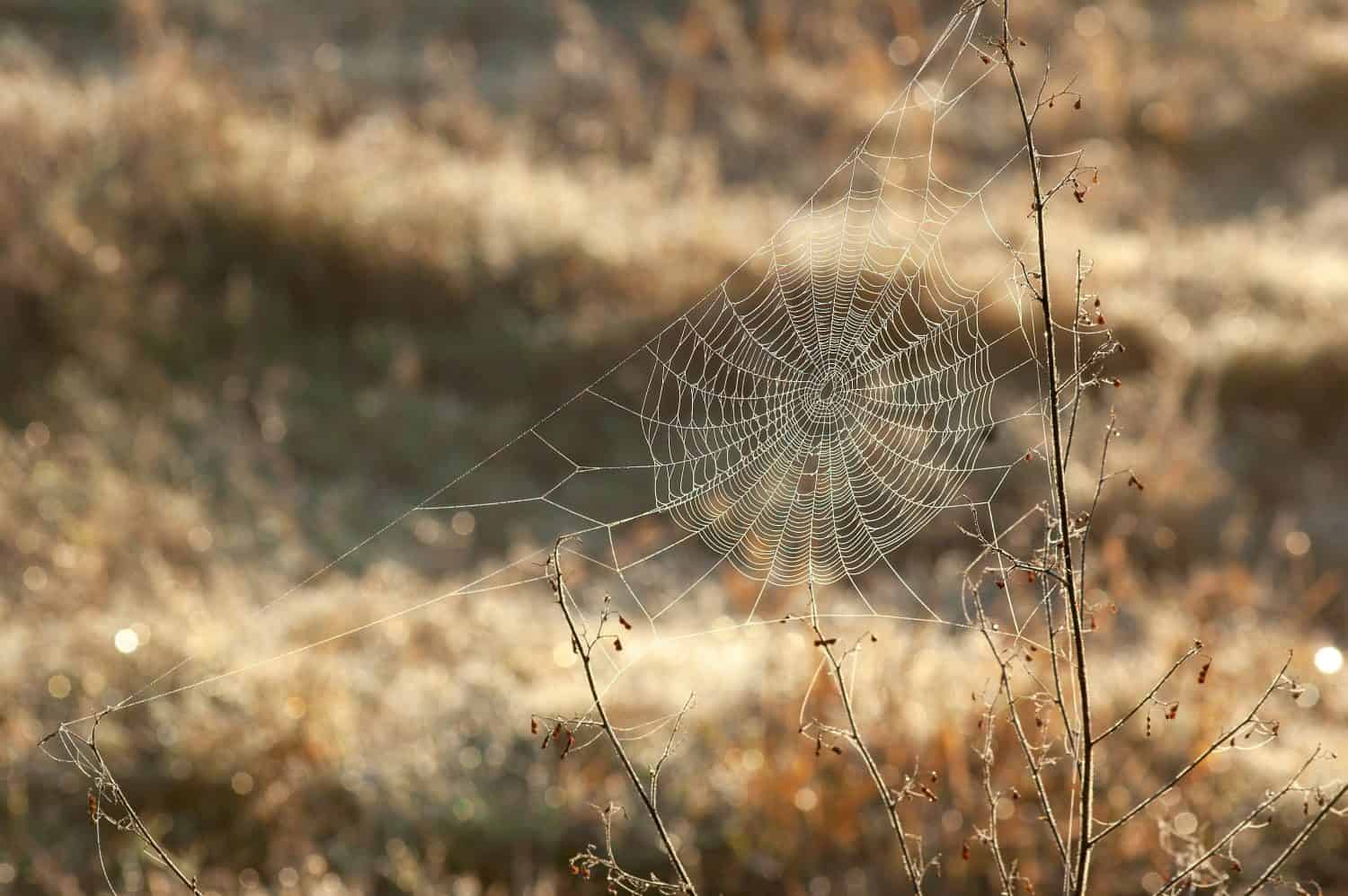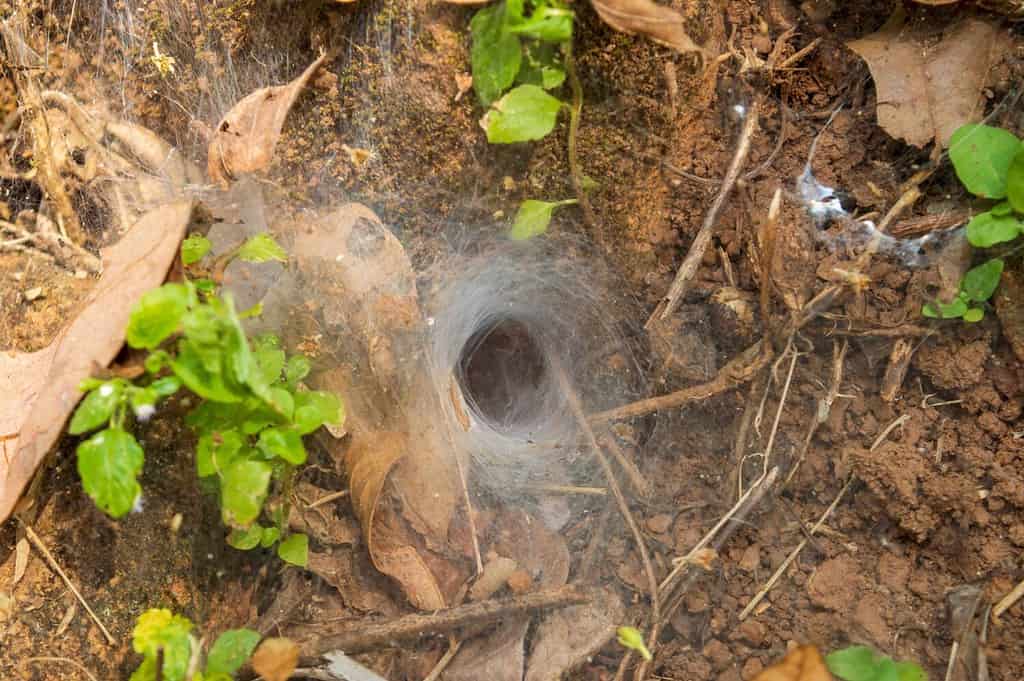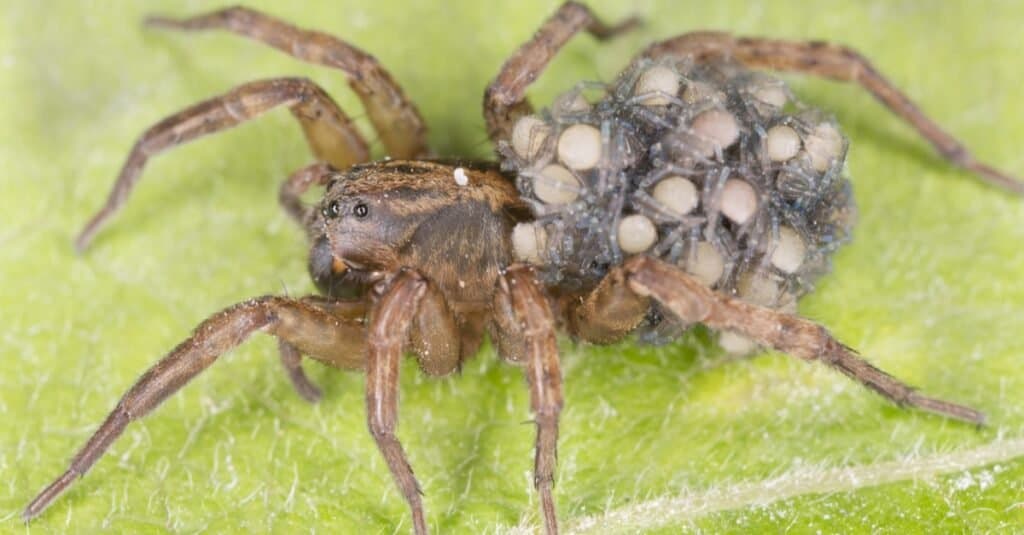Spiders coming into your home is a terrifying thing for some people. Even more alarming is finding what you think might be spider eggs! Spiders eggs often mean hundreds more spiders growing and preparing to hatch into or around your home. Some spider species are venomous and cause humans a great deal of pain and distress. Not only that, but some spider venom is so toxic it kills people without immediate treatment. So, let’s find out how to identify spider eggs and how to get rid of them!
Spider Egg Identification
Identifying a spider’s eggs involves a few steps. All of these spider egg identification steps can be accomplished from a safe distance and without disturbing the spiders. Read on to learn more!

Generally, spider egg sacks look like small bits of cotton.
©Chloe Langton/Shutterstock.com
What Do Spider Eggs Look Like?
Well, most of the time, spiders lay hundreds of eggs within a sack they create out of spider silk. This is the same substance they use to build their webs. The goal is to protect the eggs from predators and keep them at the right temperature (incubation). Most spiders securely attach the egg sack to their web for safekeeping. However, some spiders carry the egg sac with them on their back. Others create many smaller egg sacks to better ensure the survival of their young. Make sure what you’re seeing is actually a spider egg sack before trying to remove it or destroy it.
In order to correctly identify spider egg sacks, you must pay close attention to several things:
- Size: Spider egg sacs are rarely larger than a U.S. quarter.
- Shape: Most of them are round or round with bumps, kind of like a cotton ball. Others may look like a disk with a rounded part in the middle.
- Color: Spider egg sacks most often appear white or off-white, though some are brown, yellow, or even greenish. If you see a pink or black cotton ball-like fluff, it’s unlikely to be a spider egg sack.
- Texture: As spider egg sacks are made from spider silk, they usually appear fluffy like cotton.

Some spiders make multiple egg sacks.
©non exclusif mes photos/iStock via Getty Images
Where Do Spiders Lay Their Eggs?
Now that we’ve learned about how to identify spider egg sacks, let’s discover how to tell what kind of spider may have laid them. With more than 45,000 known spider species in the world, narrowing your list down is an important step in spider egg identification.
Where’s the Web?
Paying attention to the location of the spider eggs can help you identify them. Is it hidden between the bricks of your house or between the rivets on tree bark? Maybe they’re under the porch or in the high corners of a room. Perhaps you found an egg sack in a hole in the ground. Wherever the spider eggs are will help you identify the spider that laid them. Tarantulas often lay their egg sacks in burrows in the ground, while many cobweb spiders build webs in houseplants.
What Kind of Web?
Just as critical in identifying spider eggs as the location of the web is what type of web the spider made. Spider webs are separated into six types. The web types include orb weaver, triangle, funnel, tangle (cobweb), mesh, and sheet. Some spiders, such as brown recluse spiders and huntsman spiders, actively hunt their food and do not use webs.
Orb-Weaver Spiders and Identifying Their Eggs

Orb-weavers build their egg sacks in the center of their web where they protect them.
©Jordon Sharp/Shutterstock.com
Aptly named orb-weaver spiders, over 4,000 different species fall under the Araneidae family. This family is one of the most commonly found spiders across the entire world. Like most groups of spiders, the name comes from the shape of their web.
The English word “orb” can be used to reference something circular. Orb-weaver spiders create webs with spokes like a wheel in a design that ends up appearing like a circle. Similar to a dreamcatcher, each section connects to the next forming a sort of grid that helps the spiders catch prey as they fly through the web. Orb-weaver spiders come in various shapes, colors, and sizes. Several of the most colorful spiders in the world are orb-weavers.
The yellow orb weaver, spiny-backed orb weaver, and cat-faced spider all belong to this family of spiders. Common characteristics of this group include eight eyes and hairy or spiky legs. The family consists of more than 160 different genera (a further separation down from family).
Spider egg identification for orb weavers involves looking for a round, white to yellowish lump of webbing surrounded by a circular shaped web. The female will likely place the egg sack close to the stabilimentum. That’s the zigzag pattern in the center with thicker pieces of silk. The stabilimentum stabilizes the center of the web and allows the spider to sit and wait for a meal.
Triangle Web Spider Egg Identification and Web Description

Triangle web spiders create webs with three (or more) attachment points, which make a triangle shape once filled in.
©Donna Bollenbach/Shutterstock.com
As the name implies, triangle webs are shaped like triangles and built by members of the Uloboridae family. Made up of just under 20 different genera and about 300 species, triangle web spiders use their webs specifically to catch prey. Sometimes, they even form large colonies with a messy tangle of overlapped webs in order to catch as much prey as possible.
Some of these spiders are also called orb-weavers, but they are classified separately. That’s because they don’t have venom, have different web shapes, and have different spider silk. Spiders of this family include the triangle spider and the humped spider (grey house spider).
Common characteristics among these spiders include dull coloring and a hump in their backend. Identifying spider eggs from triangle web spiders is simple. Each egg sack will be about the size of the adult spider with roughly 30 eggs in each. They are made of loosely woven silk and the spiders make several of them, usually. Again, these spiders are non-venomous and may be helpful in eliminating pests. This is especially true in gardens and greenhouses.
Funnel-Web Spiders and Identifying Their Eggs

The
Atracsidaefamily of spiders get their common name from their webs that resemble funnels.
©NNphotos/Shutterstock.com
Funnel-web spiders (family Atracidae) include three genera and 36 known species. Most of them call Australia home. Often referred to collectively as Australian funnel-web spiders, funnel-web spiders also live in New Zealand, parts of Europe, the Americas, and Canada. This family possesses deadly venom. Known as atracotoxins, which are extremely toxic to primates, including humans.
Species in this family include the well-known Sydney funnel-web spider, which is Australia’s most venomous spider species. The venom from this species is widely studied by human medical researchers. A common type of funnel-web spider in the Americas and Canada is the hobo spider.
As the name suggests, the funnel-web spiders create a web that draws prey down into their burrow. They also create “trip lines” that radiate out from the entrance to the burrow as an early warning system. These outlying silk strings both catch prey and alert the spider to threats to their burrow.
Males wander during mating season, which is when most people encounter them. Of all the bites recorded with a known specimen identified, all were from male funnel-web spiders. The bites are so deadly that Australian doctor Strutan Sutherland and his team developed an anti-venom in 1981. It is still widely used today!
Common appearances found in this family are a shiny carapace (or outer shell), no obvious pattern, and a mating spur on the second set of legs of males. Funnel-web spider egg sacks are identifiable by their large-sized disc with a domed center. They often resemble a closed mussel shell.
Identification of Tangle Web Spiders and Their Egg Sacks

Webs that overlay many pieces of silk in a seemingly random pattern are tangle webs.
©0leJohny/Shutterstock.com
Tangle web (cobweb) spiders create webs that combine layers of silk in a messy arrangement. The benefit of this design is in its simplicity. The spiders easily repair the web when damaged and don’t spend a lot of time making them. These webs can be attached from the ground to a plant to catch ground-dwelling prey like ants. They also work well near lighting to catch moths and other flying insects. These are the webs usually seen high in the corners of homes and offices.
Many common house spiders belong to this family (Theridiidae) such as the terrifying black widow spider. Black widows bite an astounding 300 million people per year in the U.S. Thankfully, only roughly 4-8 of those bites are deadly. In fact, the last recorded death from a black widow bite in the U.S. was in 1983. Medical advancements allow for quick and efficient treatment. Only female black widows bite.
Other spiders in this family include the common candy-striped spider and the common house spider.
Identification of these spiders involves looking for a very round abdomen, eight legs all attached to the cephalothorax (upper segment of the body toward the head), and two miniature legs called palps at the front of the head. They also have eight eyes! Tangle web spider eggs are frequently white to cream-colored with one or multiple spikes of webbing protruding from the sack’s surface.
Mesh Webs and Spider Egg Identification

The green lead web spider, up to 0.1 inches long, is the largest of the family Dictynidae.
©Dario Lo Presti/iStock via Getty Images
The family Dictynidae is made up of over 650 species worldwide in four different genres. Interestingly, for their size, these spiders possess an incredible amount of venom.
Their common name, mesh web spider, comes from their webs that often cover large areas. The window screen-like web is typically laid over the top of bushes or other plants. The goal of this web is to catch anything and everything that crawls or lands on it. Because they are quite small, these spiders tend to congregate in groups building massive nets of webs covering entire plants or even walls. These group webs may contain several egg sacks from various females.
Spiders in this family include the diving bell spider among many others that do not have common names. Due to the unbelievable amount of species within the group, most of them go by their scientific names. The green leaf web spider (Nigma walckenaeri) is the largest of these species measuring up to just 0.1 inch long. That’s shorter than the average length of a piece of short-grain rice!
To identify these spiders, look for eyes. They either have no eyes or 6-8 eyes in two rows. Their second set of legs are longer than the rest and, of course, they are tiny. These spiders tend to place their round white, or off-white egg sack at the center of the mesh web. Then they place several layers of web around the egg sack to protect it.
Sheet Web Spiders and How to Identify Their Eggs

The red grass spider is a dwarf spider that weaves a flat, tight web.
©Robert Webster / xpda.com / CC-BY-SA-4.0 – License
Similar to mesh web spiders, sheet web spiders (Linyphiidae family) weave webs that cover large areas. They, too, are very small spiders measuring no more than about one-third of an inch long. However, these spiders differ in that they almost always build webs on or near the ground.
Unlike orb-weavers, these spiders do not use sticky silk to make their webs. Instead, they create a maze of silk strings to tangle up their prey. Sheet web spiders respond quickly to vibrations in their web so they can quickly secure their prey. Members of this family are most often found among crop plants such as corn.
More than 2,000 species make up this family including the blacktailed red sheetweaver (red grass spider) and the bowl and doily weaver.
Common characteristics of these spiders are a large space between the eyes and mouth along with an abdomen that is longer than it is wide. Sheet web spiders usually build lower-profile (more flat) egg sacks that resemble discs suspended within the web.
How to Get Rid of Spiders and Their Eggs?

Remember, some spiders carry their eggs with them. That means killing the mom and the eggs at once is a top priority!
©Henrik Larsson/Shutterstock.com
Now that we’ve learned so much more about spider egg identification, what types of spiders build what webs, and where to look for spider webs – how do you get rid of spiders and their eggs in your home? Let’s get down to business! There are many ways to rid your home of spiders and their eggs along with methods to keep them out.
Do It Yourself
- Vacuum: That’s right! Suck up the spider, the eggs, and the web all in one fell swoop. Then, just empty the canister outside or seal the bag and throw it away. This method is less than ideal if you’re afraid of spiders as the egg sack will likely open in the process. It’s also not the best for venomous spiders as emptying the canister or bag could result in bites from the dispersing spiderlings. If vacuuming is your choice, you can always freeze the bag or canister for a few days to kill the spiders.
- Bleach and Water: Chlorine bleach is a toxic substance. Mixing it with some water in a spray bottle is a quick way to kill both spiders and their egg sacks. If the spiders are on furniture or plants, this method isn’t a great idea since bleach will discolor your property and destroy living plants. This method may be very useful when it comes to spiders that carry their eggs, like wolf spiders.
- Over-the-Counter Pest Sprays: You can also buy sprays from your local grocery or hardware store designed for killing spiders. Because spider egg sacks have a water-proof coating, you’ll want to select an oil-based product. Spray the eggs, the web, and spiders directly. Make sure to follow all instructions on the package such as wearing a respirator and/or gloves.
- Sticky Traps: If you’re looking for a passive way to eliminate spiders or deal with ones that don’t build webs, these non-toxic traps might be perfect for you. They work by trapping them in glue and basically starving them to death. They’re not the nicest or quickest way, but effective in most cases. Sticky traps are usually very inexpensive, as well.
Call in the Professionals

The most effective way to get rid of spiders is to call an exterminator.
©LightField Studios/Shutterstock.com
For arachnophobes, major infestations, or to prevent spiders from returning – consider hiring an exterminator. They can easily kill off any infestations and put down a chemical barrier to prevent spiders (and other bugs) from entering your home again. This barrier often needs to be reapplied every month or so. Exterminators are trained to use chemicals with specific safety measures to ensure the job gets done properly and no humans are harmed in the process.
Final Thoughts on Spider Egg Identification and Elimination
We’ve learned a lot about spider egg identification along with determining what type of spider has invaded. Make sure that any time you deal with spiders, you take steps to ensure your own safety. When in doubt, call an exterminator. This ensures the problem is dealt with quickly, efficiently, and safely.
The photo featured at the top of this post is © Chuck Evans(mcevan)”./ CC BY 2.5, via Wikimedia Commons – License / Original
Thank you for reading! Have some feedback for us? Contact the AZ Animals editorial team.






